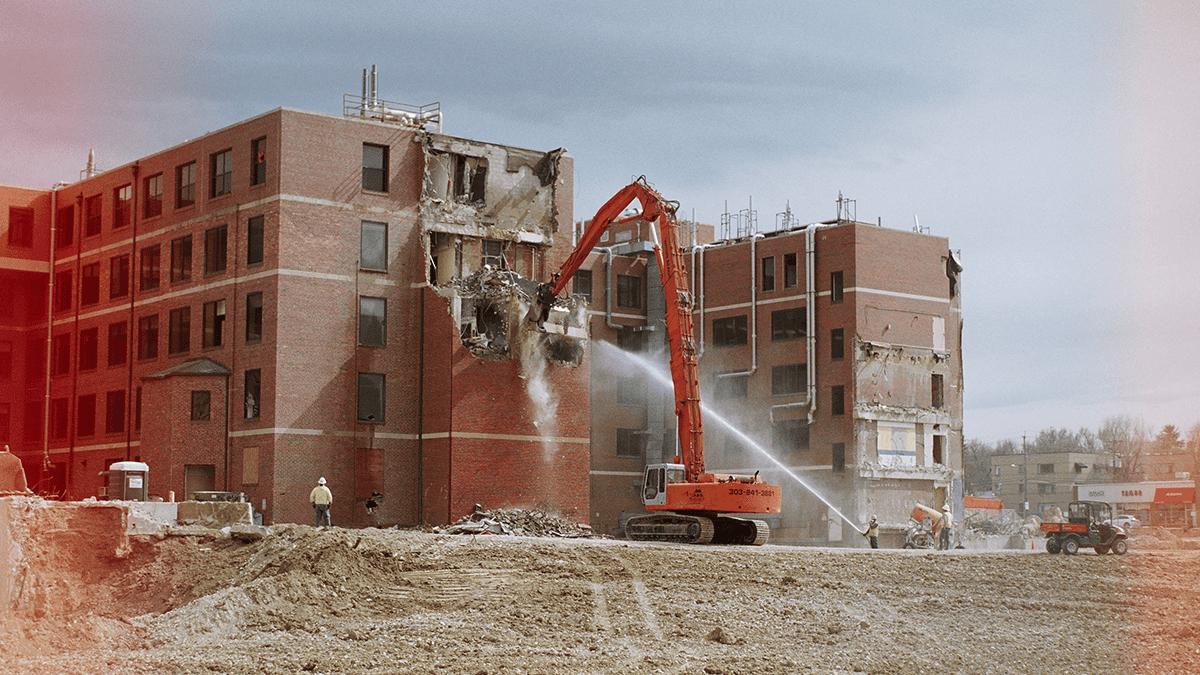Welcome to Engineer Academy where we’re exploring an A to Z of Engineering – everything from acoustics to zoos.
In each episode, we spin the wheel to find out what type of engineering we’ll be exploring with the help of Engers, our engineering expert.
You can listen to the full series of the A to Z of Engineering here.
Let’s take a look at Demolition Engineering.
With buildings, what goes up… must come down – well, at least when it’s reached the end of its useful life. Demolition is the name given to the engineering of safe tearing down of structures.
In the UK, around 50,000 buildings are demolished each year, creating over 40,000 million tonnes of waste. These buildings could be as small as a house or as tall as a skyscraper. Now you might have seen videos of explosions and wrecking balls demolishing large structures like factories, power stations and blocks of flats, but there’s more to demolition than a large bang!
For smaller projects, it’s pretty simple. They use tools such as pneumatic drills and lump hammers, and mechanical vehicles like cranes and bulldozers.
Embed from Getty ImagesLarger buildings need more powerful equipment – like wrecking balls which are heavy metal balls on chains which are swung by cranes against the structures. They’re particularly good at smashing up masonry – that’s things like stone and concrete but they can also be used for other materials too. Although they look like giant conkers on a string and are fun to watch, they aren’t the safest of equipment so are only used as a last resort.
Embed from Getty ImagesMetal beams and similar structures might be cut up using angle grinders and flame cutters such as Oxytorches.
Other tools that can help make short work of a project are things like rotational hydraulic shears and rock breakers which can slice through wood, steel and concrete – and are great to use when using flames would be dangerous.
So that’s a lot of tools in the armoury – but whether big or small, how do you get demolishing?
The first step is to carefully inspect the building and any plans of the structure to identify any dangerous or harmful materials such as asbestos which can cause health risks if breathed in. Any such materials must be carefully removed. Utility supplies such as gas, electricity and water must also be disconnected. When all the preparations are complete, it’s time to get to work.
For small buildings, hydraulic excavators can be used in what’s called an undermining process. This is where the lower parts of a structure are smashed to topple the building over. Demolition engineers are specialists at knowing exactly where to hit to get the building to fall in a controlled and safe way, falling in a safe direction that leaves the rubble in the right place for the clean-up operation.
Embed from Getty ImagesIn some cases, machinery will be used to demolish a structure down to a manageable height, before it’s then undermined. To control dust, water hoses are used to maintain a wet demolition. These might either be held by workers, secured in fixed location or attached to lifts to gain elevation.
But what if your building is quite large, like a tall chimney, a smokestack or even a bridge? Well, they can be destroyed by implosion using explosives.
Embed from Getty ImagesImploding a structure is very fast—the collapse itself only takes seconds—and an expert can ensure that the structure falls into its own footprint so as not to damage neighbouring structures. This is essential for structures in dense urban areas. The process is far from risk free though – and badly executed could be disastrous. Falling structures may damage neighbouring buildings and flying debris can injure onlookers. It can also be dangerous when the explosives partially fail – that might mean a structure ends up tilting at a dangerous angle and because of undetonated explosives, it can be difficult to approach safely.
Embed from Getty ImagesAnother danger to consider is the air over-pressure that occurs during the implosion. If it’s a clear day, the shock waves will travel quickly upwards but if there’s dense clouds, shock waves will travel sideways and that could cause damage to nearby buildings. Controlled explosions are pretty spectacular to watch but they’re really only used if no other method is possible because of these risks.
Preparing for an implosion takes a lot of work. Anything of value like copper piping, or anything that could cause harm in the explosion like glass will be removed. Engineers will select specific columns within the structure to attach the explosives. Holes will be drilled and high explosives placed in each hole. Smaller columns and walls might be wrapped in detonating cord. Engineers will try to use as little explosive as possible and will plan a progressive collapse, with detonators going off one after the other. Areas with explosives are covered in materials to reduce flying projectiles, and workers and onlooker will be kept at a safe distance. Then it’s time for the countdown! 3… 2… 1…
As you can imagine, large structures will generate a LOT of rubble and the clean up operation can take a long time. Today, much of the demolition waste can be reused. It can be crushed up to make what’s called an aggregate – a key ingredient in concrete and road building.
Embed from Getty ImagesSo that’s our take on the letter D for Demolition! It’s been a delight!
If you would like to check out some other types of engineering, why not check out Design, Drainage, Drilling or Device engineering.
Join us again next time to spin the wheel and explore another letter in the A to Z of Engineering!
Engineer Academy: A to Z of Engineering.
Created with support from a Royal Academy of Engineering Ingenious Grant.
Add a commentA to Z of Engineering
Engineering is all around us! We’re exploring an A to Z of everything engineering from acoustics to zoos.
More From A to Z of Engineering






